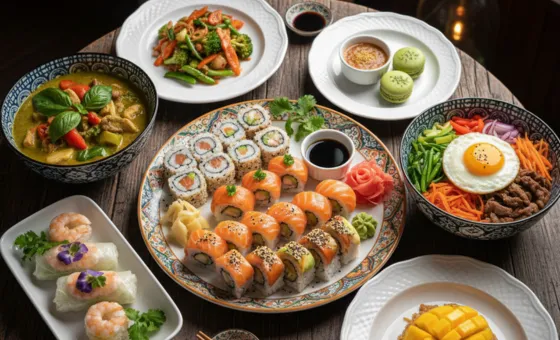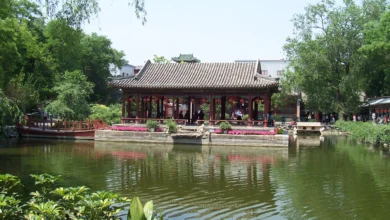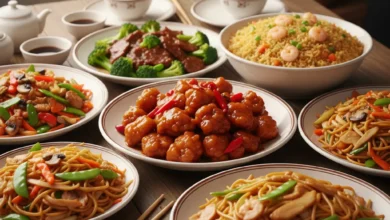Asian Garden Menu Guide: Dishes & Dining Experience

If you were to call me right now and ask, “What’s the Asian Garden menu all about before I head there for dinner tonight?” I’d walk you through it step by step, just like I would to a friend. It’s more than a menu; it’s an introduction to a dining experience that blends Asian flavors with a sense of comfort and variety. Let’s dive into what makes it special.
Table of contents
What is the Asian Garden Menu?
The Asian Garden menu is essentially a curated journey through some of Asia’s most beloved dishes. It’s not restricted to one region, like just Chinese or Japanese food. Instead, it often pulls from multiple culinary traditions, meaning you might start with a plate of crispy dumplings, move into a bold Thai curry, and finish with something sweet like green tea ice cream.
What makes it unique is that it doesn’t just hand you a list of meals. It reflects balance: light starters, hearty mains, vibrant rice and noodle dishes, and desserts that don’t weigh you down. It’s designed for both the cautious eater who sticks to familiar favorites and the adventurous diner ready to try something new.
How Does It Work?
If you’re new to dining at a place like this, the Asian Garden menu usually flows in a way that makes sense. You’ll start with small bites like spring rolls, lettuce wraps, or fried dumplings. Soups and salads often follow, from a comforting hot and sour soup to a refreshing sesame-based Asian salad.
Then come the entrées, where the real heart of the menu lives. You’ll see stir-fries with chicken, beef, seafood, or tofu, each paired with signature sauces such as teriyaki, garlic, or spicy chili. Noodles and rice dishes are a big part of the offering too, whether you’re in the mood for chow mein, pad thai, or a classic fried rice. In many locations, you’ll also find sushi rolls or sashimi platters for an added touch of variety.
And of course, it all rounds off with desserts and drinks—think mochi, mango pudding, or bubble tea. The structure is simple but intentional: start light, enjoy a satisfying main, and close on a sweet note.
Enjoying the Asian Garden Menu
Walking into a restaurant for the first time is occasionally stressful due to the choice presented in most eateries. The menu at Asian Garden is designed to be very much user-friendly. However, navigating it will make a better experience dining there.
Start with Balance in Mind
Do not try to go straight to a rich heavy main dish. Organize a well-balanced lineup. Start off with a rather light appetizer, perhaps a soup, and then work into your hefty entrée with rice or noodles. That way, you’re not filling up too quickly to enjoy dessert, yet, as it will be overly filling.
Dare To Go Beyond Your Comfort Zone
As such, most people end up with the same order for fried rice or lo mein anytime. Yet, there are things in the menu’s Asian Garden that may not particularly be listed, but could count as hidden treasures. Look for those with an indication of being “chef’s special” or something for the season. These generally showcase authentic flavors or unique combinations that will not be found in many other menus.
Why is the Asian Garden Menu Relevant Today?
Food culture has shifted. People don’t just want to eat; they want a full dining experience. That’s where the Asian Garden menu fits perfectly. It’s important today because it reflects how modern diners approach food: they want comfort but also options to explore.
The menu often uses fresh herbs, seasonal vegetables, and authentic sauces to strike a balance between traditional tastes and modern presentation. You don’t feel like you’re stuck choosing between bland dishes or overly complex fusion you get a blend of both worlds.
What Makes It Stand Out?
Not every menu achieves what the Asian Garden menu does. What sets it apart is that it offers plenty of variety without overwhelming you. You don’t find yourself flipping through endless pages; instead, each section feels purposeful. Many restaurants also highlight house-made sauces or chef’s specials that give the menu its own personality.
It’s also a menu that considers everyone at the table. If you’re vegetarian, there are tofu and veggie stir-fries. If you’re gluten-free, you can opt for tamari-based sauces or rice noodles. If you’re a first-timer, you’ll find familiar options like sesame chicken or lo mein that ease you in.
Which Dishes Should You Try First?
If you were asking me for a quick recommendation, I’d say start simple but balanced. A plate of crispy spring rolls makes a great introduction, followed by hot and sour soup to warm you up. For a main, Mongolian beef is a classic if you enjoy bold flavors, while teriyaki chicken works well if you prefer something sweet and savory. House fried rice is always a safe and delicious addition, and if you’re up for something more adventurous, try Thai basil shrimp. To finish, I’d suggest mochi or green tea ice cream—light, refreshing, and just enough sweetness to wrap things up.
How Does Dining with Asian Garden Menu Feel?
Dining here doesn’t feel rushed or routine. It feels more like an experience you can tailor to your own mood. Some people approach it family-style, ordering multiple dishes to share, while others prefer to stick with one entrée and a side. Either way, the structure of the menu gives you balance—it never feels like too much or too little.
That’s what makes it versatile. You can go on a casual weeknight, on a date, or even for a small celebration. The food adapts to the occasion, and the variety ensures nobody leaves the table unsatisfied.
Is It Affordable?
Pricing is usually one of the first things people ask me about, and the good news is that the Asian Garden menu typically offers a comfortable middle ground. Starters and soups are light on the wallet, entrées are moderately priced for casual dining, and sushi or premium dishes fall on the higher side but remain reasonable for their quality.
Many locations also have lunch specials that give you the same flavors in slightly smaller portions at a fraction of the cost. So whether you’re looking for a quick bite or a full dinner, the menu doesn’t put too much pressure on your budget.
What Should You Know Before Ordering?
A few quick tips go a long way. Don’t hesitate to ask about spice levels—most places will happily adjust the heat to mild, medium, or extra spicy. Always check out the house specials; these are usually the chef’s pride and can’t be found anywhere else. Seasonal dishes also rotate in, so you might discover something new on your next visit. And if you enjoy pairing food with drinks, look for sake, Asian beers, or specialty teas to enhance the experience.
If you’re interested in exploring more menu varieties, you should also take a look at our detailed guide on the Happy Garden Menu. It dives into the flavors, popular picks, and what makes that menu special. Together, both menus show how Asian dining continues to blend tradition with modern tastes.
Conclusion
If you’re wondering whether it’s worth it, I’d say absolutely. The Asian Garden menu is designed to make dining feel like more than just a meal. It’s about exploring flavors, enjoying variety, and finding dishes that suit everyone at the table. Whether you’re a first-timer or a repeat guest, there’s always something new to enjoy.
Next time you’re deciding where to eat, keep the Asian Garden menu in mind. It’s not just about what’s on the plate. It’s about the experience that comes with it.
You also like this: garden calculkator
FAQs
Q1: Does the Asian Garden menu include vegetarian or vegan options?
Yes, it usually does. You’ll find tofu stir-fries, veggie noodles, and plant-based curries that cater to vegetarian and vegan diners.
Q2: Are there gluten-free dishes on the Asian Garden menu?
Definitely. Rice-based dishes and gluten-free sauces make it accessible for those avoiding gluten.
Q3: What’s the most popular dish on the Asian Garden menu?
Favorites often include Mongolian beef, sesame chicken, and house fried rice. Sushi rolls are also a frequent crowd-pleaser.
Q4: Is the Asian Garden menu the same at every location?
Not entirely. The core dishes remain, but many locations add regional or seasonal specialties for variety.
Q5: Can kids enjoy the Asian Garden menu?
Yes, with milder dishes like teriyaki chicken, fried rice, or lo mein, it’s very kid-friendly.





